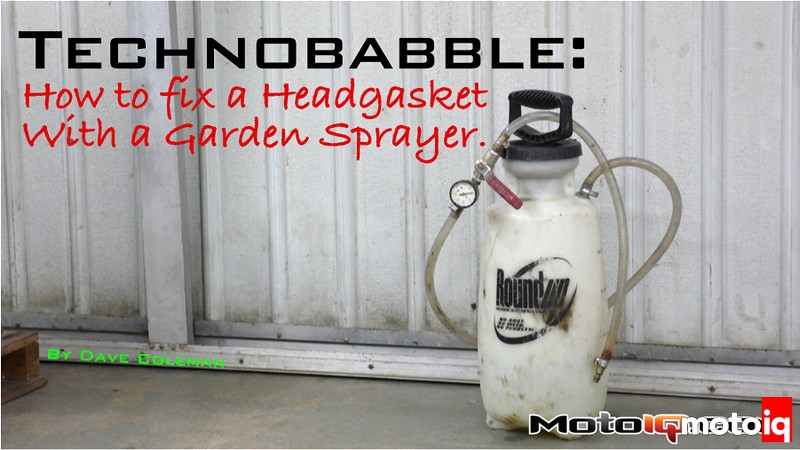,
Ignore all the little black box theories about what's really going on inside my poor, abused engine, and you just have a slow coolant leak. All I really need is to be able to re-fill the cooling system between stages. Only problem is that when you pull the radiator cap right after a stage, all the remaining coolant jumps out and burns you silly. So, really, all I need is some way to fill the cooling system between stages without pulling the radiator cap or depressurizing the cooling system.
 |
|
The gauge lets you know when the bottle pressure is higher than radiator cap pressure, and the valve lets you pump it up without spraying water all over your shoes.
|
My Nismo radiator cap says 1.3 kg/cm2, which is how the civilized, metric part of the world says 18.5 psi. That means any time the cooling system gets over 18.5 psi, the cap will open and coolant, or probably air, will pump into the overflow bottle.
Now, if I could get some water to 20 or 30 psi and somehow connect it to the cooling system, the problem would be solved. Fluid will always flow from a high pressure area to a low pressure are, so as long as I can supply air at more than 18.5 psi, I can pump it into the closed cooling system.
Time for an engineering field trip to the hardware store. First, we need a cheap quick-release fitting that can hold at least 18.5 psi and let us connect a hose to the cooling system while it's hot. Air tool fittings handle over 100 psi, and they cost about $1.43. One female fitting with 1/8 NPT threads and one male with a hose barb on it total $2.86. Now, if I were to connect this air fitting to a bottle of coolant and plug it into the engine, the 18.5-psi coolant would flow out of the engine and into my 0-psi bottle. No good.
We need a valve so we can pressurize the water before connecting to the engine. A ball valve with 1/4 NPT threads on both ends is $8.56. Now we need a pressure gauge so we know we have enough pressure to pump into the engine, but not so much that we blow the radiator hoses off. That's another $8.50. We need some fittings to connect everything, some clear vinyl hose (rated to 50 psi) so we can see which way the water is flowing, and some hose clamps to hold it all together. That's another $12.46. And a container to hold the water and some way to pressurize it? You guessed it, a garden sprayer I found sitting in the back of my van. I already had it, so that's $free.fifty-free.
 |
|
To actually get the water into the cooling system, just weld an NPT bung to a piece of pipe, splice it into the upper radiator hose, and thread in a female air tool fitting. Now you can connect the bottle to the cooling system without ever lowering the pressure.
|
The garden sprayer, miraculously, will make 30 psi of pressure, which is just enough to blow the clear vinyl hoses off your fittings if you happen to test it in your kitchen without any hose clamps. The female air tool fitting threads into a short pipe that gets spliced into the upper radiator hose.
So, with the engine hot and still running, all I do is pump the sprayer up to 30 psi, connect the fitting, and open the valve. Water rushes into the upper radiator hose and immediately flows to the radiator, where it mixes with the water already there and warms up enough not to shock the engine (that's why you use the upper hose and not the lower one.) Eventually the pressure in the bottle equalizes with the pressure in the engine and water stops flowing. If the overflow bottle isn't gushing water yet, all I have to do is start pumping the sprayer and, one pump at a time, water flows into the hose until the system is full and the air bubbling out the radiator cap bypass and into the overflow tank becomes water.
 |
|
The garden sprayer has outlasted two race cars and now serves the 24 Hours of LeMons winning Frankenmiata.
|
Fiendishly clever as I like to think I am, the seed for this idea, I have to admit, came not from my fertile mind, but from Kurt Jung of Realtime Racing during a conversation in the pits at Sebring. Of course, he wasn't going to use hardware store junk to build it for $32.38.
This system, by the way, could be an endurance racer's dream, if that endurance racer happens to be in the 23rd hour of a 24-hour race and starts losing coolant. Hey, it's been known to happen, and from this point forward, anyone endurance racing without an air fitting on their engine and a garden sprayer in their pit is a damn fool.



1 comment
This is solid gold! We’ve been battling this issue for some time on our Honda Integra with no love seeing coolant temps north of 110 C causing the ECU to cut the power until the temps drop. We are halfway through the above recommendations with a custom cross-flow radiator and a radium coolant expansion tank to help with removing air pockets from the system. test day coming up shortly